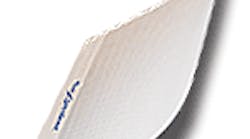Thin Speaker Technology Gets Ready To Revolutionize Audio Markets
Researchers at ITRI, reportedly Taiwan’s largest high-tech research and development institution, have found a method for creating arrays of very small, bendable loudspeakers that they can combine to produce high-fidelity speaker systems of almost any size. Designers can create speakers using standard printing techniques and later cut the flexible speakers into any shape necessary with a pair of scissors.
THE TECH ADVANTAGES
According to ITRI, the FleXpeaker components are essentially electrostatic speakers. Existing standard speaker technologies use a thick, rigid material for their speaker cones. But FleXpeaker employs a thin electret film, initially less than 0.1 cm thick, consisting of thin layers of paper and metal (Fig. 1).
The end result is a speaker measuring less than 1 mm thick. Departing further from the norm, this thin film is very flexible, enabling an extremely wide range of shapes and configurations, as well as other creative variables.
The technology also boasts significant power reductions. For example, ITRI claims that FleXpeaker components will consume 90% less power than traditional speakers when deployed in an automotive audio system. In addition to extending battery life, this makes the technology environmentally friendly.
Considering the thin profile, light weight, and low power consumption, the FleXpeaker technology will prove to be both effective and adaptable for wired and wireless products alike, with potential across a wide range of industries, limited only by the imagination of the designer. In addition to car audio systems, these applications include flat-screen televisions, MP3 units, and advertising such as billboards and public-announcement systems.
SIZE, SHAPE ARE NO OBJECT
In an envi ronment where designers would be happiest fitting everything on the head of pin, FleXpeaker appears to allow users to have it any way they want. Small, medium, and large speakers are all possible (Fig. 2).
The largest speaker ITRI has cranked out so far measures 2.5 m long by 0.5 m wide. Because of this ability to produce a larger-sized component, the FleXpeaker is a viable contender for use in energy-saving buildings, electric vehicles, and large-scale entertainment and medical applications.
Additionally, the speakers can be cut into just about any shape. Using a unique integration technology, FleXpeaker components can be integrated into clothing, wallpaper, and an array of consumer packaging, i.e., audible greeting cards.
HOW DOES IT SOUND?
With a frequency response from approximately 500 Hz to 20 kHz, these speakers best suit mid-range to high-frequency applications. According to ITRI researchers, this range is especially suitable for expressing sophisticated changes in medium- and high-frequency ranges, such as the chirping of birds and insects, which are on par with traditional speakers. For larger home and studio systems, the addition of a woofer or subwoofer would at least be desirable.
“We plan to carry out technology transfer of largesize paper-thin flexible speakers to mass production by early 2010 and complete R&D of the flexible transparent speakers in plastic material by 2010. ITRI is seeking to license the technology or create a spinoff company to commercialize the product. We expect FleXpeaker technology to be available for new B2B product development and licensing later this year,” said ITRI general director Yi-Jen Chan.
ITRI is now in discussions with several American companies. For a demonstration, visit www.youtube.com/watch?v=LNgYToJC1RA. For details, visit www.itri.org.tw/eng.
